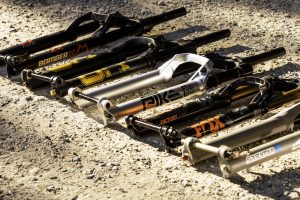Assembled and tested in the USA, this next generation Cane Creek Inline coil shock for XC and trail bikes is now smaller and stronger than the previous version.
Cane Creek DB Coil IL (Next Generation) shock review
This is an updated coil sprung DB IL (in line) shock from Cane Creek and it’s had a noticeable makeover. But is it good enough to take a place in our list of the best mountain bike rear shocks?
Its extra strength comes from a thicker damper shaft, and the dramatic size reduction is from shrinking the four-way damper valve zone to afford more frame clearance. The bulbous upper portion, where all the damper oil circulates, is now 17mm narrower and still offers independently-adjustable high and low-speed compression and rebound damping, and the brand’s proprietary Climb Switch Lock Out. A magnetically-attached Allen key tool for quick on-the-fly adjustments slots in too, which wasn’t on the first-generation IL shocks.
Cane Creek’s damper has such a wide tuning range, that on top of changing coil spring rate to set sag, there’s scope to dial it in for any rider weight or frame kinematic. The design uses two main chambers; one compression and one rebound, separated by the adjustable valves, and compared to other shocks in its class, there’s significantly more (40-50%) oil inside. This makes it more equivalent to many piggyback designs seen on DH or enduro bikes, which the brand says should translate to less fade, more control, and greater consistency when riding.
A coil shock like this can excel on aggressively-angled short travel bikes like the Norco Optic or Transition Spur, and deliver extra suppleness and tracking. Assuming you know what you’re doing, ride feel can be set anywhere from hyperactively fast and bouncy, through to super dull and damped. This extra plushness brings a weight penalty over an air shock of up to 500g depending on spring rate, but for some smaller shock sizes, it’s much less, and even as low as 200g.
The new DB coil IL won’t fit every down-country or trail bike, and even with a thicker wall on its 8mm damper shaft, it’s still not suitable for bikes like the Specialized Stumpjumper, where a longer shock extender yoke that can place excessive side loads on the shaft.
If you’ve ever ridden a coil, you’ll be familiar with that pitter-patter feel at the rear tyre that’s very hard to emulate with an air shock. The IL has this in spades, and whether climbing up spidery roots, or clawing for grip on tricky descents, tracking is excellent. Another key characteristic is how fast it changes direction, so you can really sense the rear tyre tracing terrain on successive hits with more precision than many stock shocks. Absorbing heavy flat landings after drops is also smooth and very well-controlled, with minimal trembling or bounce back on touchdown.
To counteract all this rapid movement when you don’t want it, a very effective Climb Switch neutralises weight shifts under pedalling, which is welcome on shorter travel rigs. Cane Creek’s clever design stabilises the bike in both directions to support against pedal bob and calm the shock while still retaining traction and control, and I reckon the it trumps its rivals’ low-speed compression-only lock outs that can feel sharp and staccato on rougher ground when cranking.
Coil springs obviously weigh a chunk more than air, but I’ve yet to ride an air shock that offers quite the same off-the-top sensitivity. On a short travel bike with perfectly tuned damping (like the Norco Optic with its superb custom-tuned RockShox Super Deluxe Ultimate DH air shock), there’s less of a clear-cut performance advantage than I’ve noticed using Cane Creeks’ bigger Kitsuma shock. In short, it’s not a night and day transformation in grip and tracking.
Verdict
I’d argue then this new Cane Creek Coil IL is a best solution to a bike with average rather than exceptional air suspension; especially considering the upgrade cost, and that any extra tracking and traction comes with the penalty of significant added weight. Significant on the kind of bike that feels so fun partly because of the lack of mass in the first place.
















